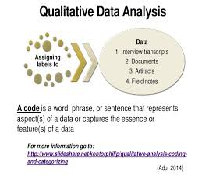Conducting Qualitative Data Analysis Order Instructions: Conducting qualitative analysis
This week you will discuss the different qualitative data analysis techniques recognizing potential weaknesses as well as the main validity and reliability concerns.

•Review the Required Learning Resources.
•Discussing critically the purposes and key issues when conducting qualitative data analyses
•Exploring the main data quality issues related to validity, reliability, and generalisability.
•Proposing ways to overcome data quality issues
•Highlighting possible ethical issues and feasibility constraints with the collection of primary qualitative data
Conducting Qualitative Data Analysis Sample Answer
Qualitative Data Analysis
The qualitative data analysis is the system in that we transform the inputs data that have been gathered as the element of the research purpose and employ it to offer the interpretation, understanding, and explanation of the situations, people and the phenomena that are studied. The fundamental role of examining the qualitative data is to investigate the symbolic and meaningful content of which is found inside. That is the purpose of trying to understand and identify such ideas, situations, and concepts. It is of greater significance that was before deciding upon the techniques of data analysis; the researcher should be familiar and confident with the selected discipline.
When analyzing data, it’s vital for the researcher to have background information on the chosen field so as to make a lot of decisions relating to the findings and the analysis. According to the Miles and Huberman (1994 cited in Collis and Hussey, 2013), they explain that systematic ways to the qualitative examination which can generally be employed for the investigation of the qualitative data vary across a range of the techniques used to collect data.
Normally, the quality analyses have three parts. That is the data reduction, data display, and lastly drawing the conclusion. That data reduction entails the condensing of the relevant quantitative data that is collected to something which is more controllable for the analysis by coding the data. Coding entails recognizing keywords, ideas, themes and phrases and additionally, it is influenced by the language the researcher uses.
There exist two types of qualitative data analysis. That is the content analysis and the thematic analysis, (Vaismoradi, Turunen and Bondas, 2013). Content analysis is used to analyze data that have been collected using primary and secondary methods across a wider range of different sources. In the content analysis, the process of coding is recognized that they entail ideas, themes, phrases and words that come into view in the data. Afterward, the data is analyzed to find out the recurrences of the sets, and they are recorded regarding numeric, (Schreier, 2012). The numerically processed data is created from this analysis and can be examined for the number of outcomes occurring by using statistical techniques. It could entail the utilization of the evocative statistics and images representing the data. The method is limited by the fact that is very time-consuming and needs very close concentration to details.
The thematic analysis is explained as the technique for recognizing, report and analysis sequences inside the data, (Braun, Clarke, and Terry, 2014). It is broadly used in the qualitative research because it is straight forward technique and it provides the researchers with essential tactics for the acceptance of other ways and more complicated methods of examining the quality data.
The uses of computer packages have helped to handle a larger number of data. The data is then represented in various formats. It entails researcher’s ideas, interviews, and documents to mention but a few. To make it efficient, as a researcher, you must do transcription so as to deal with the issue of time consumption, (Clarke, and Braun, 2013)
Conclusively, it is vital for the researcher to adhere to the ethical issue. When collecting data, the researcher should know what is right or wrong to the respondents or what is termed as morally correct or incorrect by the society. The researcher should not force people to participate but those are willing and able and qualify for the investigation should be used for analysis, (Silverman, 2016)
Conducting Qualitative Data Analysis Bibliography
Vaismoradi, M., Turunen, H. and Bondas, T., 2013. Content analysis and thematic analysis: Implications for conducting a qualitative descriptive study. Nursing & health sciences, 15(3), pp.398-405.
Schreier, M., 2012. Qualitative content analysis in practice. Sage Publications.
Collis, J. and Hussey, R., 2013. Business research: A practical guide for undergraduate and postgraduate students. Palgrave Macmillan.
Braun, V., Clarke, V. and Terry, G., 2014. Thematic analysis. Qual Res Clin Health Psychol, pp.95-114.
Clarke, V. and Braun, V., 2013. Teaching thematic analysis: Overcoming challenges and developing strategies for effective learning. The psychologist, 26(2), pp.120-123.
Silverman, D. ed., 2016. Qualitative research. Sage.




